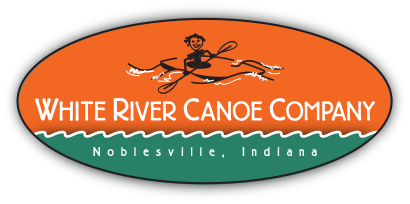Water Safety – Instruction, Tips & Safety
Rules of the Road – What Paddlers Need to Know
Canoeing, Kayaking, and Tubing are great fun, and your passion and responsible use of the White River will help to sustain it for future generations to enjoy. We offer this section to help you enjoy the river safely, and to emphasize that we SHARE it with others who may enjoy it by different means than simply paddling or floating.
The following are a few “Rules of the Road” to use when sharing the river with fishermen, motorized craft, other paddlers and tubers, and people who are simply enjoying the river from the bank or wading in the shallows.
Be Aware of your surroundings, including the river conditions and potential obstructions ahead of you, and other river users who might be coming from behind you. Fishermen in jet drive boats use the river frequently, and you can hear their motors from some distance. Move to the side and let them pass, especially in shallow areas where they cannot slow down or stop without damaging their motors.
Be Considerate of fishermen, whether they’re in a boat, canoe, kayak, or on the bank. Give them as wide a berth as safely possible, and don’t linger in the area where they’re fishing. There are parks, campgrounds, and walking trails along the river in various places where families with young children take quiet walks through the woods to skip rocks and wade in the shallows. Your voice and what you say travels a long way on the water.
Navigate the river as you do the smaller county roads or city streets you drive on. Keep to the middle of the river to avoid brush and logs on the sides when you’re not passing or being passed. Move to the Right for oncoming traffic and to let faster paddlers and boaters pass from behind. Pass other slower paddlers on the Left. Communicate with others in your group and in your vicinity about potential obstacles ahead, and faster craft coming from behind.
Be a Good Citizen of the river community. Do not litter and do not bring Glass. Help friends or strangers who are in trouble.
DNR Conservation Officers patrol the river, and can see you at greater distance than you see them. They’re working to support your safety, the health of the river, and compliance with state laws. Have your life jackets. Do not use illegal drugs. Have your fishing license. Don’t drink alcohol if you’re under the legal age. Don’t act out or announce your public intoxication. Do not sink your cans, or otherwise litter. Much of the land along the river is privately owned, so you are probably trespassing if you leave the river bank.
10 Ways to Paddle Safely
- Always Wear Your Life Jacket – Wear a properly fitting U.S. Coast Guard-approved life jacket at all times on the water.
- Don’t drink while paddling – Avoid alcohol, which impairs the coordination and balance you need to control a canoe or kayak.
- Stay Low – Learn how to enter and exit your boat safely and stay low in your boat when possible. Most paddlesport-related drownings are the result of capsizing.
- Keep Your Balance – Don’t overload your boat. Distribute passengers, secure gear evenly and low.
- Practice the Wet Exit – Learn how to get out of, hang on to, right, and re-enter your capsized boat.
- Don’t Get Left in the Cold – Dress for the weather conditions and be prepared for coldwater immersion. Hypothermia is a danger any time of year.
- Plan Ahead – Know the water you’re paddling, plan your day of paddling, and file a float plan so that someone knows where to find you and when you plan to return.
- Never Paddle Alone – Companions can come to your aid if you get in trouble. New paddlers should paddle with someone more experienced… it’s a great way to learn and remain safe if there’s a mishap.
- Be in Command – Know how to move your boat forward, back, and sideways, and how to stop using paddle strokes. Watch ahead for hazards like undercut rocks, bridge pilings, large branches and trees, big drop-offs, or other boats.
- Learn about Your Boat – Consider taking a canoe or kayak safety class.
A wearable life jacket for each person must be aboard
These life jackets must be:
- US Coast Guard approved
- The proper size for the intended wearer
- In good and serviceable condition
- Properly stowed (readily accessible)
- When a vessel is underway with children under 13 years old, they must be wearing a life jacket
If a life jacket fits properly it will help keep your head above the water. Too big, and the life jacket will ride up around your face. Too small, it will not be able to keep your body afloat. Life jackets designed for adults will not work for children
Try it on for size
- Check the manufacturer’s label to ensure that the life jacket is a proper fit for your size and weight
- Make sure the jacket is properly fastened.
- Hold your arms straight up over your head
- Ask a friend to grasp the tops of the arm openings and gently pull up.
- Make sure there is no excess room above the openings and that the jacket does not ride up over your chin or face
- For the best fit, try the life jacket in shallow water under safe and supervised conditions
